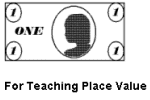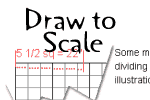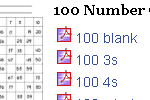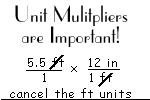Earlier today, I was studying over the economics/government Lifepac (1200) and below is a one way to break down and plan a 10-book set of lifepac workbooks.
On notebook paper, I dissected the program and that is the first step in most planning jobs.
It has 10 workbooks like most lifepacs.
Each workbook contains a Unit Test (1 test x 10 workbooks = 10 days, no study time for these)
--10 days so far--
Inside each workbook, I see that there are *3 sections and after each section there is a test. (3 tests x 10 workbooks = 30 days, 3 study days x 10 workbooks = 30 days. = 60 days)
--70 days so far==
(* How many sections a lifepac workbook has can vary from book to book.)
Each section is divided into parts and they vary, so I go through each book and record how many parts there are. Throughout the 10 workbook set there are 82 parts. I determine that each part can be completed in one day. (82 parts x 1 day each = 82 days)
152 days altogether, which equals 30.4 weeks, which leaves 5.6 weeks for extra study time and reading extra books on the subject such as What Happened to Penny Candy.
So now I print (or open) a semester planner and enter each part to do in sequence without skipping any boxes. My son will do each part in turn no matter what day of the week it is.
That's all for that one.
For the schedule that I made for Alpha Omega Publications History and Geography for Grade 12 - Government and Economics, go to: http://donnayoung.org/history/index.htm#schedules
More Pages at donnayoung.org that have lifepac planning examples as well as basic lesson plans:
AOP Lifepac Art Unit I Lesson Plans
donnayoung.org/art/aop-art-unit-1-lesson-plans.htm
Lifepacs Elective Art Unit 4 - Lesson Plans
donnayoung.org/art/perspective-aop-elective-art-unit-4.htm
Planning Guide- AOP LifePac Electives Art - Unit 7 Comics
donnayoung.org/art/aop-art-unit-7-comics.htm
Alpha Omega General Health pacs 708 and 709 Lesson Plans
donnayoung.org/forms/help/go/aoh.htm
Alpha Omega Press LifePac Electives Art Plan
donnayoung.org/art/aop-plan.htm
Lesson Plans for Alpha Omega's Elective course Home Economics
donnayoung.org/forms/help/go/home_ec_6-10.htm
I had already decided that we would take two years to go through the program. So today, I looked over the first 5 units.
Looking it over, I see that sewing (clothes with a machine) is in unit 5. I want to teach my daughter to sew well, so we will plan to spend the entire last quarter on unit 5.
AOP lifepacs are basically workbooks and they are very easy to schedule. This course will have hands-on work to do and so I went ahead and scheduled the pages and left a space under each unit schedule to make notes about activities.
Unit 1 will have 20 days of workbook
Unit 2 will have 18 days of workbook
Unit 3 will have 32 days of workbook
Unit 4 will have 31 days of workbook
I haven't worked out the hands-on days or what my daughter will do on those days, but there are 19 free days for hands-on learning for the first 4 units. (This number is based on 32 weeks instead of a 36 week school year--- (8 weeks per quarter instead of 9 weeks))
Unit 5 has not been worked out yet.
Note: Lifepac Electives Home Economics has been renamed to Lifepac Electives Family & Consumer Science Set.

The image just shows Unit 3 and this was planned on a legal pad. I do just about all of the planning on a legal pad unless I know how the curriculum works. The home ec course is unfamiliar to me, so it goes on the legal pad until it is all worked out.
Unit 3 has 4 sections and they are noted in the left column, I, II, III, IV.
Next to the sections are numbers that you probably can't see and the number sets have lies between them .. something like this:
1-5 | 6-9 | 9-10 | and so on. Those are the page groups that are to be completed. The | | marks separate each day.
In the far right side are some numbers and these numbers are the total amount of days each section will take.
Underneath is a blank area and I'll use this area to note any hands-on activities that should be done. It is blank right now since I haven't done that part yet.
I'm going to thumb through each book again and take note of the "Complete the following activities" parts that are scattered throughout the books. These are the hands-on things that my daughter will do.
Anyway that is how I am making plans for this Lifepac.
I have used Life Pacs in the past ... wasn't overjoyed with them, but if they have a good economics course, then I might look into it.
If you wanted to try a real-books approach these are some books that some homeschoolers use:
Whatever Happened to Penny Candy, by Richard Maybury, 1993
Biblical Economics in Comics, by Vic Lockman, 1985
Economics in One Lesson, by Henry Hazlitt, 1979
Honest Money, by Gary North, 1986
A Banker's Confession, by Gary Sanseri, 1991
I bought this one:
Whatever Happened to Penny Candy, by Richard Maybury, 1993
How do you know how many days it will take? Just by the amount of work in each section?
I have to get back to my planning today!
Thanks for sharing this, Donna. It is a help.
The amount of days is the total of the groups of page assignments. Like these page assignment groups: 1-5 | 6-9 | 9-10 | are three groups and will probably take 3 days. When I'm going through the workbook, I look over the content to determine how much work is there. Most of it is reading and answering questions, but sometimes there is an activity to do. At that point, I make a decision about the activity and if it should take an extra day or not.
I went over the units again last night to record the activities. Unit 3 has 12 activities. Some of those can be done in addition to page assignments, but others, like the one where she must bake a pie from scratch, will be done in between workbook days, so the pie day will add a day to the total. Some of the other hands-on assignments can be completed as part of a family meal and she can still have a workbook assignment on those days, so those activities won't add a day.
These are the steps that I did when planning Lifepac Home Ec Unit 6.
----------------------
Home Economics Lifepac 6
lesson plans worksheet
***Looking at student's book***
Contents Overview:
The parts and comments:
I: A brief history of interior decoration, 1-16 includes a test
II. Introduction to design and decoration, 17 - 33 includes a test
III. Specific treatments, 34 - 46 includes a test
IV. Visual enrichment, 47 - 58 includes a test and suggests a field trip to
"model homes"
V. Sewing for the home, 59 - 63 includes a sewing project
***Looking at teacher's book***
Materials list:
3-ring notebook
white paper - 8.5" x 11"
magazines, ads, and catalogs depicting furniture
markers or crayons, pencils, eraser, ruler, scissors, tape measure
graph paper
3" x 5" cards
tracing paper
decorating samples (see teacher book for more details, page 33)
recommended to have: Ziploc bag for templates - This will go in the decorator
notebook your child will make.
NOTE: This materials list does not
include materials that will be needed for the sewing project. Supply list for
sewing project will be based on what project child chooses to do.
***The amount of time we can spend on this***
Time allotted: 6 weeks (up to 30 days)
NOTE: This may be too slow a schedule if you are planning to complete all 10
Lifepacs in one school year. We are using 5 lifepacs per year, taking two years
to complete the Home Ec course.
***Choosing a planner***
Use a 5 x 6 grid, thumb through book taking note of activities, questions, tests, field trips, etc. and start filling in page numbers, try not to overload:
| I. Read glossary, discuss words that you are puzzled by, look up any words that you cannot pronounce in the dictionary and learn to pronounce them correctly. Read pages 1-2 | 3-6 stop after answering questions | 7-11 |
12-14 Includes activity: you'll need 15 3x5 cards and magazines, ads, and catalogs depicting furniture |
Self test 1 |
| II. 17-22 includes coloring activity, you'll need markers or crayons, if you do not wish to color in your workbook, use color wheel printable at donnayoung.org |
22-27 | Practical Techniques of Interior Design This starts the decorator notebook 28: notebook activities: 2.38, 2.39 |
29 notebook activities: 2.40, 2.41 | 29-30 notebook activity: 2.42 |
| 30-31, notebook activity: 2.43 study for self-test 2 in remaining time |
Self test 2, pages 32-33 | III. 34-36 | 36-38 | 38-39 |
| 40-42 | 42-44, study for self test in remaining time | Self test 3, pages 44-46 | IV: 47-50 | 50-52,
over weekend or sometime during this unit, visit model homes |
| Finishing decorator notebook: 54-56 Requires trip to home decorator stores |
Self test 4, pages 57-58 | V: Sewing for the home 59-61 |
61-63: This includes a sewing activity and you can take a few days for this. Will need to buy sewing supplies | |
| After completing the sewing project, study the entire unit, the glossary to prepare for the unit test. The day after you finish studying, take Unit Test 6 (finish sewing project by Wednesday, take test by Friday) | ||||
It is really just a day by day plan so a person can get an idea of how long a workbook will take and it can be compared with the child's other day by day plans to see the total workload for one day.
I like your highlighted notes. Tidbit of information like that, comes in handy. I'll have to go back over my plans and see if I need to add any tidbit information.
This is what I do next. I check the schedule against some points..
1. Time off: Typically during the first semester, we have 10 days off.
2. Will the day be overloaded when compared to other schedules.
3. I check the halfway point. The halfway point is never in the half though, it is around 3/5 because we normally get more work done before the end of the year than we do after New Year's.
The parts and the time they should take:
Unit 6: 6 weeks
Unit 7: 4 weeks and 4 days
Unit 8: 5 weeks
----------halfway point----------
Unit 9: 5 weeks and 4 days
Unit 10: 7 weeks
Adding them all up: about 29 weeks (That's good, I wanted it to be 30, 29 is even better. This just means that my daughter has a better chance of completing the course on time.)
The goal: Finish 6, 7, and 8 by December. That ought to be doable since from August 1 through Dec 16, there are 18 working weeks (allowing two weeks off first semester) and the work should take 16 weeks. That allows for 10 days of bumping off a class when another class is too long. And of course do unit 9 and 10 after New Year's.








Comments
Commenting is closed for this article.